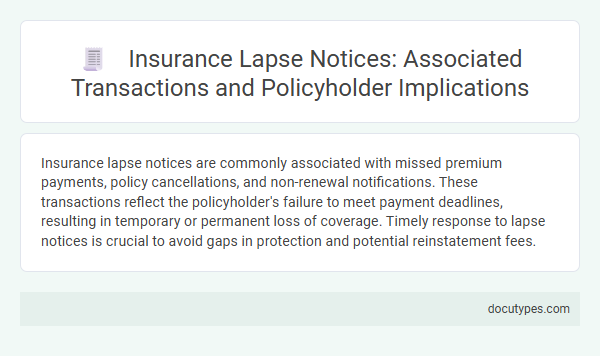Insurance lapse notices are commonly associated with missed premium payments, policy cancellations, and non-renewal notifications. These transactions reflect the policyholder's failure to meet payment deadlines, resulting in temporary or permanent loss of coverage. Timely response to lapse notices is crucial to avoid gaps in protection and potential reinstatement fees.
Understanding Insurance Lapse Notices
Insurance lapse notices inform policyholders of missed payments or pending cancellations. Understanding these notices helps you avoid coverage interruptions and potential financial risks.
- Missed Premium Payment - The most common transaction triggering a lapse notice is a missed or late premium payment.
- Policy Non-Renewal - Notices may be sent when a policy is set to expire without renewal, signaling potential lapse.
- Policy Cancellation Request - A lapse notice can also result from a formal cancellation requested by the policyholder or insurer.
Common Causes of Insurance Policy Lapses
Insurance lapse notices are typically associated with transactions involving missed premium payments and policy cancellations. These notices alert policyholders that their coverage may terminate due to non-payment or failure to meet policy requirements.
Common causes of insurance policy lapses include financial difficulties, overlooked payment deadlines, and policyholder misunderstandings. You can prevent lapses by monitoring payment schedules and promptly addressing any billing issues.
Key Transactions Triggered by a Lapse Notice
| Transaction Type | Description | Impact on Policyholder |
|---|---|---|
| Premium Payment Reminder | A notification sent to policyholders indicating a missed or overdue premium payment. | Alerts the insured to make payment to avoid policy cancellation or lapse. |
| Policy Status Update | System-generated update reflecting the change in policy status from active to pending lapse or lapsed. | Triggers administrative procedures and informs all stakeholders of current policy condition. |
| Grace Period Initiation | Activation of a set timeframe during which missed payments can be made without the policy lapsing. | Provides the insured a final chance to reinstate coverage without losing benefits. |
| Reinstatement Offer | Proposal sent to policyholders post-lapse offering options to restore coverage, often requiring back payments or new underwriting. | Enables recovery of lapsed coverage, possibly with revised terms or premiums. |
| Cancellation Processing | Transaction that officially records the termination of the insurance policy following non-payment beyond the grace period. | Ends policy coverage and liability of insurer for future claims under that policy. |
Timeline and Process of a Policy Lapse
Insurance lapse notices are critical communications sent when a policyholder's premium payments are overdue, signaling potential termination of coverage. Understanding the timeline and process of a policy lapse helps in managing insurance risks effectively.
- Initial Non-Payment - A missed premium payment triggers the issuance of a lapse notice, alerting the policyholder to the overdue status.
- Grace Period - The policyholder is granted a specific time frame, typically 30 days, to pay the outstanding premium before coverage is terminated.
- Policy Termination - If payment is not received within the grace period, the insurance policy officially lapses, ending the insurer's obligation.
Timely response to lapse notices is essential to avoid coverage gaps and maintain continuous insurance protection.
Policyholder Obligations Upon Receiving a Lapse Notice
Insurance lapse notices alert policyholders about overdue payments threatening policy termination. These notices inform critical actions needed to maintain active coverage and avoid financial loss.
- Payment Submission - Policyholders must promptly remit the outstanding premium to prevent policy cancellation.
- Contacting the Insurer - Policyholders should communicate with their insurer to discuss payment plans or resolve discrepancies.
- Reviewing Policy Terms - Understanding the specific conditions and deadlines in the lapse notice helps ensure compliance and continued coverage.
Financial Implications of a Lapsed Insurance Policy
What types of transactions trigger insurance lapse notices? Insurance lapse notices typically arise from missed premium payments or policy cancellations. These transactions indicate that your coverage is at risk of terminating due to non-payment.
How do financial implications manifest after an insurance policy lapses? When a policy lapses, you may face increased premiums to reinstate coverage or lose accumulated benefits. Lapsed policies can also expose you to higher out-of-pocket expenses in case of claims.
Which financial transactions are involved in reinstating a lapsed insurance policy? Paying overdue premiums and any applicable fees are necessary transactions to restore your insurance. Failure to complete these payments may result in permanent coverage loss.
What impact do lapsed insurance policies have on claims settlements? Claims submitted during a lapse may be denied or delayed, affecting your financial protection. Timely payments help maintain uninterrupted coverage and claim eligibility.
Reinstatement Options After Policy Lapse
Insurance lapse notices are commonly triggered by missed premium payments, policy cancellations, or expiration of the grace period. Reinstatement options after a policy lapse often include paying all overdue premiums, submitting a reinstatement application, and providing proof of insurability. You can typically restore coverage within a specified timeframe to avoid losing benefits and facing higher costs.
Impact on Coverage and Claims During Lapse Period
Insurance lapse notices typically involve transactions such as missed premium payments, policy cancellations, and non-renewal requests. These transactions directly impact coverage by creating gaps during the lapse period, leaving insured parties unprotected against potential risks. Your claims filed during this lapse are often denied due to lack of active coverage, emphasizing the importance of timely premium payments.
Preventative Strategies to Avoid Policy Lapses
Insurance lapse notices typically arise from unpaid premiums, policy cancellations, or changes in payment methods. These transactions signal potential interruptions in coverage that can impact the policyholder's protection and credit rating.
Preventative strategies to avoid policy lapses include setting up automatic premium payments to ensure timely transactions. Regularly reviewing policy statements and contacting the insurer for any discrepancies also helps maintain active coverage. Policyholders should update contact information promptly to receive all notifications without delay.
What Types of Transactions Are Associated with Insurance Lapse Notices? Infographic

